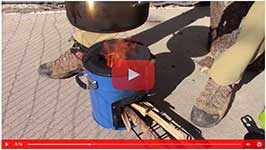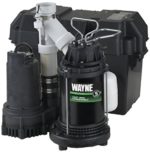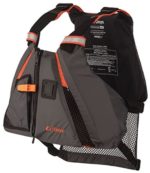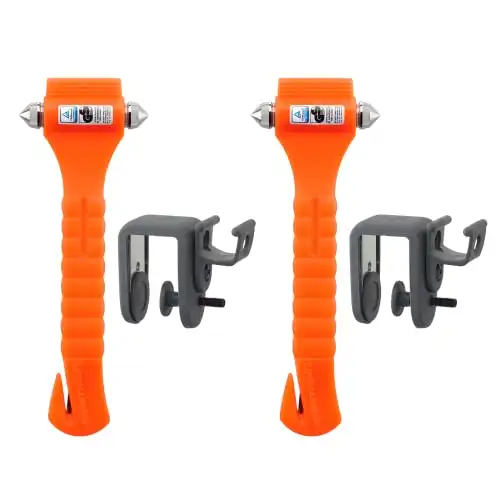Today I’ve got something incredibly important to share…
A Complete Guide On How To Prepare For (& Survive) A Flood
Because sometimes the waters rise; fast. Too fast!
When streets turn to rivers, and water laps at your doorstep.
Sometimes sandbags and plywood are not enough to halt the advance.
Every era in human history has dealt with devastating floods.
Some are a product of hurricanes; while most are from seasonal storms.
But regardless of the cause, property and lives are lost for those unprepared.
TOPICS IN THIS GUIDE… ↓(click to jump)
- Real Examples Of Dangerous Floods
- Getting To Know Your Flood Type
- 3 Basic Flood Survival Categories
- How To Prepare For A Flood
- How To Survive A Flood
- Responding In The Wake

Want a free 78 item prepper checklist?
Click here to instantly download this Complete Checklist PDF. No purchase necessary.Real Examples Of Dangerous Floods
Millions of Americans currently live in floodplains and flood-prone areas.
So there’s a risk of becoming a flooding casualty – especially if you don’t know what you’re doing.
And for some reason, people underestimate the power of flooding.
They don’t realize how devastating it can be to property and the power of moving water.
Surging water will grab a human and toss them around like a rag doll.
Helplessly sweeping them away with ease and holding them underwater…
↓ Catastrophic flooding in California puts millions at risk
↓ Top 5 Largest Flash Floods (caught on video)
↓ See the Power Of Floodwater
But flooding can happen outside of floodplains as well.
Even if you think you’re safe, localized flooding can occur in more places than people realize.
On FEMA’s website, you can check to see if you live in a floodplain.
If your home is at risk, it’s in your best interest to prepare now.
Get yourself, your home, and your family ready today for the possibility of a flood tomorrow.
Getting To Know Your Flood Type
No two floods are identical; there are:
- River floods
- Coastal floods
- Storm surges
- Inland floods
- Flash floods
- Burn scar floods
You must understand which flooding types are most likely for your area to properly prepare for and ultimately survive a flood.
↓ Flood Preparedness: Know Your Floods
<3 Basic Flood Survival Categories
Now, unlike Noah, you don’t need to build an ark.
However, that isn’t to suggest surviving a flood is easy.
It requires several critical steps and a toolbox of knowledge before, during, and after a flood.
In this article, we’ll cover in detail 3 ‘how-to’ flood categories:
- How to Prepare For A Flood
- How To Survive A Flood
- Responding In The Wake
How To Prepare For A Flood
Consider Getting Flood Insurance
First, on a financial note, buy flood insurance if you live in an area prone to flooding!
You can master every trick in the book, like sandbagging, pumping, redirecting water, etc.
But if you’re not covered by flood insurance, you could lose everything financially – including your home.
So getting flood insurance is a crucial step to surviving a flood financially.
Before you buy, check out this excellent article that covers 6 flood insurance myths.
↓ Flood Insurance Explained ↓
Protecting Your Home From Water
If you know a flood is coming ahead of time, you should dam your property from the flood waters.
Damming your home and property is one of the best flood defense tactics.
Sandbags
Sandbags are the most cost-effective way to divert water away from your home.
You’ll need to procure a bunch of bags, plastic, and sand.
In extreme floods, getting your hands on enough of these can be a real challenge, so stock up now so you have what you need later.
If you already have plenty of sandbags, take some time to learn how to fill them and layer them properly for your sandbag wall to be most effective.
↓ Home Flooding Preparation – Sandbags
↓ You Got Your Sandbags. Now What?
Now, sandbags will block and divert mild flooding but stacking a massive sandbag wall around your entire house will take thousands of sandbags and a lot of work.
So you’ll want to consider some alternative solutions.
Aqua Dams
The Aqua Dam is a much faster and larger scale method to block and divert major water away from your home.
The key is to buy and install an Aqua Dam system that’s taller than the floodwaters at peak.
This is hard to predict; the taller the dam, the more costly it is to build.
This might be an excellent investment to protect your home from massive flooding damage.
Here is a video of a home protected using an Aqua Dam system.
↓ Rubber dams help protect homes from flooding
Here’s where you can find smaller versions of these dams for more mild floods.
Door Dams
If you can’t use sandbags or water dams or you want extra protection, you should look into a door dam.
Your doors are often the first place where floodwaters enter a home.
So if you dam these weak spots, your home might stay dry against minor flooding.
A door dam is a plastic or metal plate with rubber seals around the edges that bolts or screws into place to create a dam at the door.
It creates a watertight seal and keeps water from coming in under your door.
Here are a couple of videos showing varying setups.
↓ Flood shield – Flood Protection Door Barrier
↓ Image Flood Defense Ltd Installing superior flood barrier
You can find a similar product called the National Guard Flood Barrier Shield.
Invest In A Sump Pump
These devices are useful in floods because they help bail your house out as it floods.
Investing in a high-quality, high-volume sump pump will hopefully keep up with the flooding and save your home from the worst damage.
However, in the case of massive flooding, no sump pump will be able to up.
Also, get a sump pump that runs on solar and batteries, so you won’t need electricity to run it.
↓ How do I keep my basement from flooding when a power outage shuts down my sump pump
These pumps are submersible and can be set up to run water that’s entering your home.
You’ll need a way to route the water off your property.
It’s useless to run a sump pump back into the same water that’s flooding your home.
Depending on your surrounding topographical elevations, this task may be obvious or impossible.
Research Your Home’s Electrical Disconnect
When the water rises and your house is in danger of mass flooding, you’ll want to cut your electricity.
Otherwise, you run the risk of short-circuiting your electrical appliances.
Shutting off power and gas is something to do before you evacuate to higher ground.
In fact, as soon as you know a flood is inevitable, shut your electricity down because water and electricity can result in electrical fires and gas explosions.
You need to know where your electrical breaker is and which switches turn what off.
Everyone should know this information!
Find your breaker, and label each switch, so you don’t have to play a memory game every time you turn your breakers off.

Want a free 78 item prepper checklist?
Click here to instantly download this Complete Checklist PDF. No purchase necessary.Stockpile Emergency Supplies
As with any disaster situation, having a large stock of emergency supplies is “common” sense.
It’s common only because most people understand its importance.
But sadly, it’s uncommon to follow this basic survival advice.
In a survey conducted in 2012, less than half of U.S. households didn’t have 3 days for nonperishable food and water at home!
Water
Bottled water is one of the most important resources to have during a flood.
Public water often becomes contaminated (or turned off completely) during a worst-case flood emergency.
You cannot rely on your tap water or any flood waters nearby –
“water water everywhere, yet not a drop to drink.”
Drinking contaminated water can make you extremely sick or worse.
So at a minimum, buy a few packs of bottled water and keep them stored for emergencies.
Or even better, learn how to store water for the long haul.
Food
Similarly, having food is vital. Stock up on many non-perishable items like canned food and dehydrated meals.
Medical
You should also build a first aid kit and learn how to use it.
Basic medical knowledge can differentiate between life and death in a flood.
Misc. Items
Floods uproot and knock objects over, break stuff, and humans can get caught in the turmoil.
So practice treating cuts and lacerations because unsanitary water can result in nasty infections.
Stock up on flashlights and batteries since the electrical grid will likely go out.
Also, invest in long-lasting survival candles if you run out of batteries.
Insects breed like crazy after a flood in the leftover standing water.
Mosquitoes can be hellish.
By that same token, if you’re stranded on a roof with no cover and nowhere to go, you will need sunscreen.
So make sure you have some.
Neon paint is also useful in a disaster situation where rescue is the goal because it’s highly visible.
Rescuers can see neon paint better than natural shades.
If you’re using earth colors to write your “HELP!” messages, your chances of getting spotted are far lower than if you were to use neon pink.
As for storing these supplies, make sure you keep them elevated and off the ground – especially if they’re in a basement!
If you want to keep them in the basement, make sure to move them to higher points in your home before the flood.
3rd stories or even attics are better than basements in the event of a pending flood.
It would be devastating to invest in supplies, and when the time comes, you find they’re ruined because they got soaked.
Plan Your Evacuation Routes
The best way to survive a flood is to get away from it.
Nowadays, people are often warned by weather systems or news broadcasts ahead of time.
This means if one is headed at you, you’ll likely have at least some time to get the hell out of Dodge.
And if that’s the case, you want some potential evacuation routes you can take to escape the storm.
The obvious evacuation routes (interstates and highways) are prone to debilitating traffic jams.
And getting stuck in your car during a rising flood may be worse than being trapped at home.
So map out several potential evac routes.
Use back roads and pathways less likely to get congested by frantic flood fleers.
Keep a local map of your area handy in your flood supplies.
Layout three or four potential evacuation routes to higher ground and safer locations.
Your Irreplaceable/Valuable Items
Keep all your important documents in a single place.
If you have valuables like jewelry, keep them where you can grab them quickly.
I use a small home safe, where I have compiled all my essential documents and valuables in case of an emergency.
Quick access safes ensure you can grab them before the water does, and it protects your belongings against fire and theft as well.
Many great home safes are available online in every size, model, and shape you can imagine.
Yes, some are a bit pricey, but the peace of mind and ease of escape they grant you is worth the price.
Invest In Floatation Devices
Let’s say you don’t get into your car fast enough and can’t get out in time.
It’s possible you have to move to your roof with nowhere to escape.
So keep a couple of flotation devices stored with your flood gear.
You might also keep an inflatable boat or kayak, or paddle-board on hand.
That way, you can navigate floodwaters without having to swim in them.
These devices provide safe movement to search for help, look for supplies, and even help others.

Want a free 78 item prepper checklist?
Click here to instantly download this Complete Checklist PDF. No purchase necessary.How To Survive A Flood
Once the flood hits, you enter the second stage of survival.
If you’ve prepared, you have an excellent shot at getting through alive and well.
Turn Off Electricity and Gas
Remember, in preparing for a flood, you should know where your breaker is and how to use it.
Now’s the time to put that knowledge to the test.
Find your house’s power switch and shut it down!
Turn off your gas, too, as this can present explosive hazards.
Do this before you evacuate so that your house doesn’t burn down or blow up in your absence.
Flood damage is bad enough already; you don’t need to add any further disasters.
Evacuate ASAP
Don’t waste any time.
Pack your things, prepare your home, load your loved ones, and get out!
Go to high ground, where you’ll be safe and sound.
Early evacuation is the best, most efficient way to survive a flood.
Grab your bug-out bags and get the hell out.
If you’ve prepared properly, there’s nothing else you can do to help your property and things.
It’s best to leave your home and return once the flooding subsides.
If you’ve invested in flood insurance and grabbed your family and valuables, you’ve got nothing to fear and no good reasons to stay!
Anything material that’s lost can be replaced, but you or your loved ones cannot!
The Evacuation
If you leave early enough, you won’t have to deal with your vehicle flooding or having to cross flooded roadways.
However, if you left too late or didn’t have any forewarning and your vehicle submerged in deep water, get out and get to higher ground.
Get Out Of A Sinking / Flooded Vehicle
Staying inside a sinking or flooding vehicle is extremely dangerous.
↓ What to Do: Car Sinking in Water, Only Seconds to React
You can get stuck inside, suffocate, drown, or get smashed by flood debris.
So getting out fast is imperative.
You can do this with a tool called a Life Hammer.
This tool has a double-sided steel hammer that breaks through the side and rear windows.
It also has a razor-sharp blade that cuts easily through safety belts.
↓ Seat Belt Cutter And Car Window Breaker Review
But here’s the tricky part: you must be careful getting out of your vehicle.
In fast-moving floodwaters, you may jump out of the frying pan and into the fire.
If you’re not in water that will fully submerge your vehicle and think it’s more dangerous outside of it, stay in the vehicle and roll down your windows, so you have an escape route ready.
Avoid Electrified Water
You can also get electrocuted when driving, running, swimming, or paddling your way through floodwaters.
Electrified H20 occurs when electrical lines are downed during storms and submerged in water.
- If you fall into this water, it can kill you.
- Even driving through it can electrocute you and kill you.
- If someone falls into electrified water, DO NOT FOLLOW THEM IN; again, it can kill you.
You need to keep your distance and try and throw them something to grab so you can pull them to safety.
If Stuck In Your Home
Even if you decide not to leave, you still need a plan.
While we don’t recommend sticking around if there’s time to evacuate, we live in a free country.
So if you choose to stay, make sure you are extra prepared.
And if theirs a flash flood, you may need to scramble to safety and wait for rescue.
Use Neon Paint to Signal for Help
Among your stockpile, you should have some neon paint.
If you get stuck, this can be used to write on roofs, pieces of plywood, or other debris.
The neon colors make it extremely easy for rescue teams to spot people in distress.
Make bright signs that can get the attention of people who can help.
Stay Calm
Nothing is worse for a survival situation than nerves and anxiety.
Sure, nerves are a natural thing, especially in a severe flood.
However, try to keep your emotions under control – stay calm, and collected.
You’ll be better equipped to make sensible decisions and deal with challenges.
Panic is the enemy of the survival mindset.
Responding In The Wake
When the carnage is over, and the water has retreated, there will be a lot of devastation left over.
Houses will be ruined, belongings lost, and even people missing.
There’s a lot of work to do to rehabilitate your home and your community after it’s experienced a severe flood.
Here are a few of the initial steps:
↓ Flood Clean-up – 5 Steps Including Mold Control
Contacting Friends and Relatives
You’ll want to check in with people you know and care about to ensure they aren’t missing or worse.
This functions as a way to calm your worries.
But it also helps law enforcement and rescuers to know who’s still missing.
Take Lots of Pictures
Remember that flood insurance you bought?
Well, those guys will want proof you lost what you claim you lost.
So get a camera and start taking pictures of everything around your house.
Make a written list that backs up the photos.
Document everything!
It will come in handy later on when dealing with insurance companies.
Leave the Electricity and Gas OFF
As tempting as it is to turn your power back on and get back to normal, DON’T DO IT.
Leave that stuff alone until it has been properly inspected.
Not only does it create a potential safety hazard, but it also might mess with the insurance claim.
Starting an accidental fire because you wanted to test the toaster could get your insurance claim voided.
The best course of action is to document the damage as best as possible, then step back and leave everything alone until properly inspected.
Dealing With Looters
When you think you’ve survived the flood and you’re out of the woods, looters rob you blind.
Looters are an unfortunate phenomenon in areas devastated by flooding.
They are notorious for going through abandoned neighborhoods and taking anything valuable.
So make sure to fortify your home ahead of time to make your home a hardened target.
When you return to your house, stay vigilant, and protect yourself from these scoundrels.
Help Rebuild Your Community
There will be no shortage of volunteer opportunities after a flood.
It’s an intense community bonding project to rebuild the place you live in together.
It’s extremely gratifying to chip in and help others in need.
It makes you feel good to help others who need it.
And it also gives them a reason to help you later on down the road when you might need a few extra hands to rebuild your life.
Why Trust Skilled Survival...
Go here now to review a full breakdown of:
- Who We Are
- Our Credentials
- Our Mission
- & Product Recommendations...
Here are a few highlights of our teams credentials & certifications:
- Certified Member of a Mountain Search & Rescue Organization
- Plant Emergency & Safety Leader for a Major Food Manufacturer
- Member of the 10TH Mountain Division Hut Association
- Certifications: Avalanche 1, WFR, CPR
- Official Gear Tester for Numerous Outdoor Gear Companies
- Countless Multiday Backpacking trips into Remote Wilderness
- Bachelor's Degree In Mechanical Engineering
- Bachelor's Degree In Civil Engineering
- Bachelor's Degree In Biomedical Engineering
"It takes 20 years to build a reputation and five minutes to ruin it." - Warren Buffett
We're fully aware that trust is NOT something you GET but is EARNED.
And we'll continue to earn YOUR trust through our forthright and honest approach with each new Blog Post, Guide & Product we create...
Will Brendza

P.s. Do You Live In A 'Danger Zone' County?

Find out now using my Danger Zone County List & Special Report it’s absolutely FREE.
In minutes you’ll know EXACTLY where you stand and if you should be worried or not..
So click here to get my FREE Danger Zone County List & Report…

Recommended Reading
Survival Pack: How To Build One NOW (before SHTF)
Survival pack list From Scratch. Packs That Will Make You A Hero To Your Family. Plus, Some Of Th Best Packs You Can Buy
Best Survival Packing List To Plan For An Evacuation
Everyone needs a survival packing list to organize their escape. That way you won't regret leaving something critical behind.
13 Best Wild Edibles ANYONE Can Find Nearly Everywhere…
Discover the best wild edible plants you can find and eat nearly anywere. Knowing and identifying these wild edibles could save your life.
How To Make Catfish Bait: My Grandpa’s Ultimate Recipe
I want to share with you what I consider the best catfish bait recipe. Here's how to make stink bait that will get the catfish to bite.
Paracord Projects: 17 Surprising Things You Can Make
I share the best paracord projects that are both fun and useful. By doing these crafts you'll always have lifesaving cordage on hand.
Best Survival Skills Every Adventurer Should Learn
The best survival skills will keep you alive even in extreme conditions. 1. Water 2. Shelters 3. Fire 4. Navigation 5. Signaling 6. Medical 7. Foraging...







